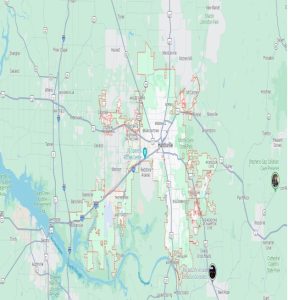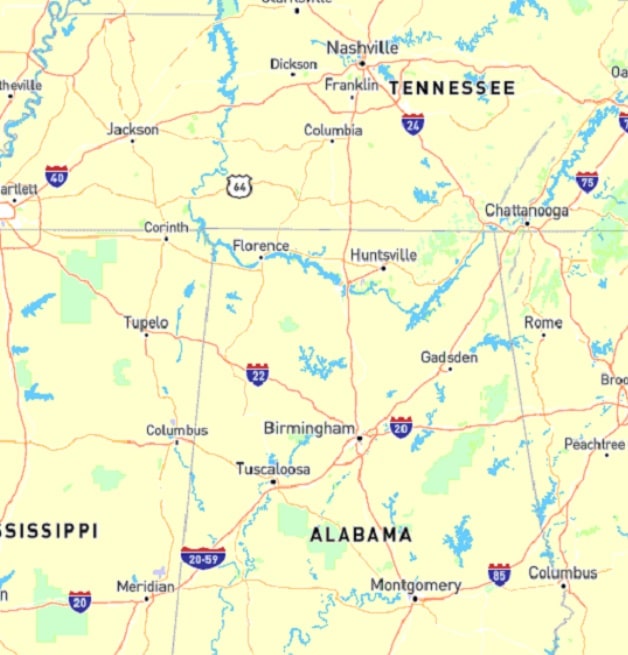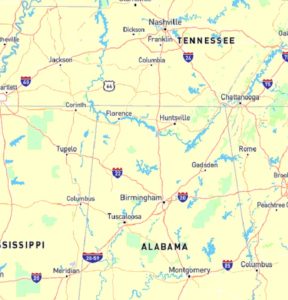Huntsville, Alabama vs Birmingham, Alabama Population and Size Compared
Huntsville and Birmingham are two prominent cities in Alabama, each offering distinct histories, cultural identities, and economic landscapes. While Huntsville is renowned for its ties to the aerospace industry and rapid growth, Birmingham boasts a rich historical significance as a center of civil rights and industrial development. This article provides an in-depth comparison of Huntsville and Birmingham, examining various factors such as population, area, historical context, economic conditions, and community life.
Geographic Overview
Huntsville, Alabama
- Location: Huntsville is situated in the northern part of Alabama, approximately 100 miles from Birmingham. It is nestled in the Tennessee Valley and is known for its proximity to the Appalachian Mountains.
- Area: Huntsville covers an area of approximately 215 square miles (557 km²), making it one of the larger cities in Alabama in terms of land area.
- Topography: The city features a diverse landscape, including rolling hills and lush greenery, with several parks and nature trails that enhance its appeal for outdoor enthusiasts.
Birmingham, Alabama
- Location: Birmingham is located in the central part of Alabama and serves as the largest city in the state. It is approximately 100 miles south of Huntsville and is situated at the foothills of the Appalachian Mountains.
- Area: Birmingham covers an area of about 148 square miles (384 km²), making it smaller than Huntsville in terms of land area.
- Topography: Birmingham’s landscape is characterized by its hilly terrain and vibrant urban center, with numerous parks and recreational areas that provide residents with outdoor activities.
Size Comparison
In terms of area, Huntsville is significantly larger, encompassing approximately 215 square miles, while Birmingham covers about 148 square miles. This difference in size reflects the distinct urban planning and development patterns of the two cities.
Population Statistics
Huntsville
- Population: According to the 2020 Census, Huntsville had a population of approximately 200,000 residents, reflecting a substantial increase in recent years, driven by economic growth and job opportunities in the aerospace and technology sectors.
- Demographics: Huntsville is known for its diverse population, including a significant number of professionals in science, technology, engineering, and mathematics (STEM) fields. The city has also seen an influx of new residents due to its economic opportunities and quality of life.
Birmingham
- Population: As of the 2020 Census, Birmingham had a population of around 200,000 residents as well, making it one of the largest cities in Alabama. However, it has experienced population decline in recent decades.
- Demographics: Birmingham’s population is diverse, with a rich cultural heritage. The city has a significant African American community and is known for its historical significance in the civil rights movement.
Population Comparison
Both Huntsville and Birmingham have populations of approximately 200,000. However, Huntsville’s population has been growing steadily due to its economic development, while Birmingham has faced challenges related to urban decline and population loss in certain areas.
Historical Context
Huntsville
- Establishment: Huntsville was founded in 1805 and is one of the oldest cities in Alabama. It was initially a cotton trading hub and later became known for its involvement in the space and defense industries.
- Historical Significance: Huntsville played a crucial role in the U.S. space program, with the establishment of the Marshall Space Flight Center in the 1960s. This has greatly influenced the city’s growth and development over the years.
Birmingham
- Establishment: Birmingham was established in 1871 and quickly became known as a major industrial center. It was built at the intersection of two railroad lines, which contributed to its rapid growth.
- Historical Significance: Birmingham is renowned for its role in the civil rights movement, particularly during the 1960s. The city was the site of significant events, including protests and marches that contributed to the advancement of civil rights in the United States.
Economic Conditions
Huntsville
- Economy: Huntsville’s economy is robust, with a strong focus on aerospace, defense, and technology. The presence of NASA’s Marshall Space Flight Center and several defense contractors has attracted skilled professionals and companies to the area.
- Job Market: The job market in Huntsville is thriving, with many opportunities in STEM fields, manufacturing, and research. The city’s economic growth has made it one of the fastest-growing metropolitan areas in the U.S.
Birmingham
- Economy: Birmingham has a diverse economy, historically centered around steel production and manufacturing. In recent years, the city has worked to diversify its economic base, focusing on healthcare, finance, and technology.
- Job Market: The job market in Birmingham offers opportunities across various sectors, but it has faced challenges related to unemployment and economic disparities in certain areas.
Educational Opportunities
Huntsville
- Schools: Huntsville is served by the Huntsville City Schools district, which includes several public and private schools known for their academic performance and extracurricular programs.
- Higher Education: Huntsville is home to Alabama A&M University and The University of Alabama in Huntsville (UAH), both of which provide various degree programs and contribute to the local economy through research and innovation.
Birmingham
- Schools: Birmingham has a number of public school systems, including the Birmingham City Schools, which provide educational opportunities to residents. The district has faced challenges, but there are also several charter and private schools in the area.
- Higher Education: Birmingham is home to several higher education institutions, including The University of Alabama at Birmingham (UAB), which is known for its healthcare programs and research contributions.
Community Life and Culture
Huntsville
- Community Events: Huntsville hosts various community events throughout the year, including the Rocket City Christmas, Panoply Arts Festival, and The Huntsville International Airport Air Show, which celebrate the city’s culture and heritage.
- Parks and Recreation: The city boasts numerous parks and recreational facilities, including the Huntsville Botanical Garden and Monte Sano State Park, offering residents plenty of outdoor activities.
Birmingham
- Community Events: Birmingham is known for its vibrant cultural scene, hosting events like the Birmingham Civil Rights Festival, Sloss Music & Arts Festival, and Birmingham Restaurant Week, which showcase the city’s rich history and culinary offerings.
- Parks and Recreation: Birmingham has many parks and recreational facilities, including Railroad Park, which provides green space for community gatherings and outdoor activities, and the Birmingham Zoo, which is a popular attraction.
Transportation
Huntsville
- Transportation Network: Huntsville has a transportation network that includes major highways such as Interstate 565 and U.S. Route 231, facilitating easy access to surrounding areas. The city is also served by the Huntsville International Airport.
- Commute: The city’s layout and road infrastructure support efficient commuting for residents, whether they are traveling for work or leisure.
Birmingham
- Transportation Network: Birmingham is well-connected by major highways, including Interstate 65 and Interstate 20, making it accessible for travelers and commuters. The city also has a public transportation system known as MAX Transit.
- Commute: Birmingham’s transportation network supports commuting within the city and to nearby areas, with various options for public transit.
Conclusion
In summary, Huntsville and Birmingham are two dynamic cities in Alabama, each offering unique characteristics and opportunities. Huntsville is known for its rapid growth, aerospace industry, and educational institutions, while Birmingham is recognized for its rich history, cultural diversity, and vibrant community life.
Both cities provide residents with various amenities, educational opportunities, and community engagement options. Understanding their differences and similarities can help individuals make informed decisions about where to live, work, and explore.
Whether one is drawn to Huntsville’s technological advancements and natural beauty or Birmingham’s historical significance and cultural vibrancy, both cities contribute significantly to the diverse landscape of Alabama.
Huntsville, Alabama vs Birmingham, Alabama Map
Check out the map below to see where these cities are located, and click on the pins to see their populations.






